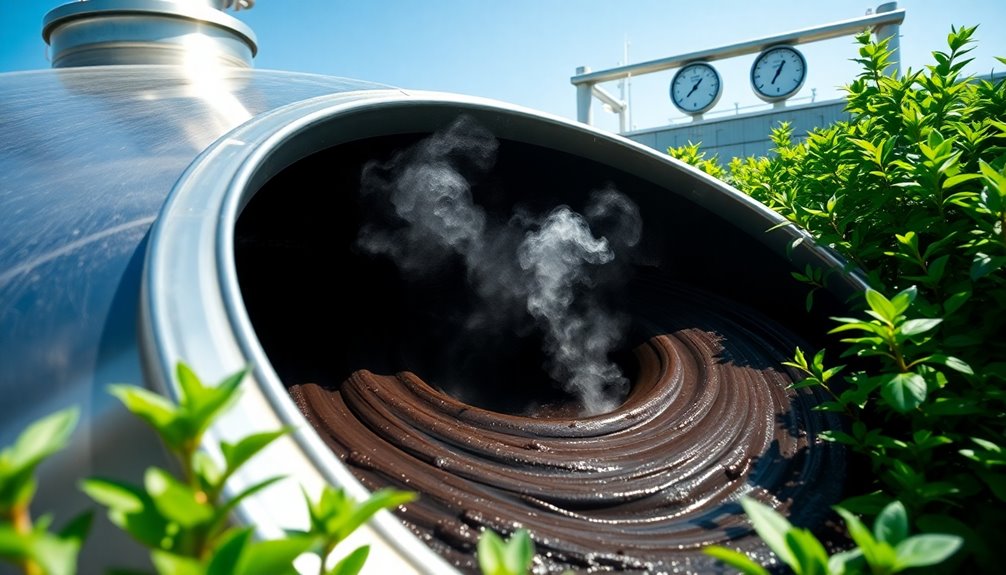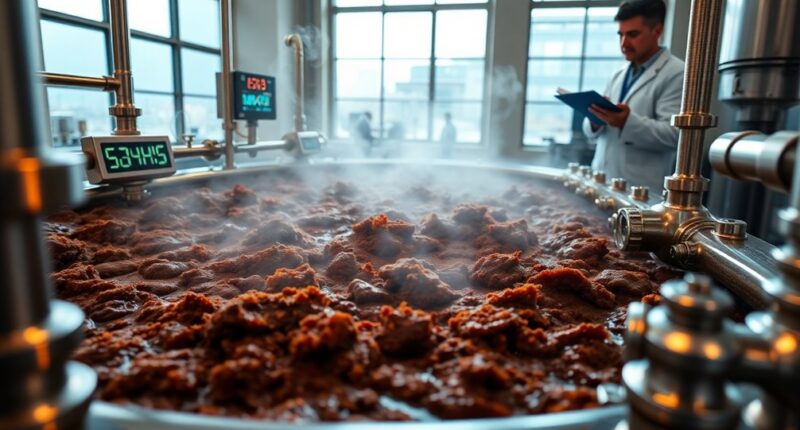Assessing semi-thermophilic anaerobic digestion reveals its potential for higher methane production and improved operational stability. By operating between 40°C and 60°C, it balances rapid biochemical reactions with consistent output. Monitoring key factors like pH, C/N ratio, and microbial diversity is essential for maximizing efficiency. This method not only increases energy recovery but also meets environmental regulations. If you're interested in exploring the specifics of optimizing this process, there's much more to discover.
Key Takeaways
- Semi-thermophilic anaerobic digestion operates between 40°C and 60°C, facilitating rapid biochemical reactions and increased methane production compared to mesophilic systems.
- Maintaining optimal pH levels (6.5 to 8.5) and alkalinity is crucial for operational stability and efficient methane generation.
- A balanced carbon-to-nitrogen (C/N) ratio enhances microbial activity, reduces ammonia toxicity, and supports overall system performance.
- Understanding methanogenesis pathways, particularly acetoclastic and hydrogenotrophic processes, maximizes methane production efficiency.
- Promoting microbial diversity improves system resilience and stability, positively impacting methane yield in anaerobic digestion processes.

Assessing the potential of anaerobic digestion is essential for optimizing energy production from organic waste. When you explore semi-thermophilic anaerobic digestion, you'll find it strikes a balance between the rapid biochemical reactions of thermophilic conditions and the stability of mesophilic systems. Operating typically between 40°C and 60°C, semi-thermophilic digestion offers increased methane production while maintaining reasonable process stability.
Semi-thermophilic anaerobic digestion optimizes methane production by balancing rapid reactions and process stability.
In this temperature range, the microbial activity accelerates, resulting in higher methane yields compared to traditional mesophilic systems. You'll notice that the semi-thermophilic process retains some advantages, like reduced pathogen levels, which can help meet strict environmental regulations.
However, it also demands careful monitoring of environmental factors such as pH and volatile fatty acid (VFA) concentration to prevent process destabilization. Maintaining optimal pH levels between 6.5 and 8.5 is crucial for promoting microbial activity. You should also focus on alkalinity, which acts as a buffer against pH fluctuations caused by VFA accumulation. Additionally, monitoring restoration potential is vital to ensure that methane production remains efficient and the system is stable.
As you balance VFA concentrations, remember that high levels can inhibit methanogenesis, ultimately affecting your methane yield. The carbon-to-nitrogen (C/N) ratio also plays a vital role; ensuring proper nutrient availability can help reduce ammonia toxicity.
The methanogenesis step is where the magic happens. Understanding the pathways, particularly acetoclastic and hydrogenotrophic processes, is essential for maximizing methane production. By knowing that acetic acid serves as a major precursor for methane, you can better optimize your system.
Also, consider the microbial diversity, as it significantly impacts both yield and stability.
Frequently Asked Questions
What Are the Primary Feedstocks for Semi-Thermophilic Anaerobic Digestion?
When it comes to semi-thermophilic anaerobic digestion, you'll find several primary feedstocks that work well.
Animal manure is a popular choice due to its nutrient content, while food waste provides high organic material for biogas.
Wastewater sludge helps reduce pathogens, and organic municipal waste can enhance methane production.
Additionally, agricultural residues like straw or corn stalks can be effective.
Combining these feedstocks can significantly boost digestion efficiency and methane yield.
How Does Temperature Affect Microbial Activity in Anaerobic Digestion?
Did you know that methane production can increase by up to 30% when temperatures rise from 30°C to 50°C?
In anaerobic digestion, temperature directly influences microbial activity. As it increases, you'll see enhanced metabolic processes, leading to higher methane yields.
However, if temperatures exceed 55°C, microbial activity may decline, destabilizing the process.
Balancing temperature is crucial to maintain efficient digestion and optimize methane production while ensuring microbial diversity and stability.
What Are the Benefits of Semi-Thermophilic Over Mesophilic Digestion?
You'll find that semi-thermophilic digestion offers several advantages over mesophilic digestion.
It achieves higher methane production due to increased metabolic rates and a balanced microbial community, leading to more efficient breakdown of organic matter.
Additionally, its operational flexibility allows for better tolerance to temperature fluctuations and lower energy requirements.
You'll also benefit from improved pathogen reduction and a safer digestate, making it a more cost-effective and environmentally friendly option overall.
Can Semi-Thermophilic Digestion Handle High Solid Concentrations?
Think of semi-thermophilic digestion as a skilled chef handling a complex dish.
Yes, it can manage high solid concentrations, but you've got to stay vigilant.
While higher solids can boost organic loading and methane production, they also risk acidification.
You'll need to optimize mixing strategies and monitor conditions closely to ensure effective mass transfer.
With the right adjustments, you can harness the benefits of this dynamic digestion process while maintaining stability.
What Are Common Challenges in Semi-Thermophilic Anaerobic Digestion Systems?
In semi-thermophilic anaerobic digestion systems, you'll face several common challenges.
Temperature sensitivity demands careful control to maintain stability, while microbial adaptation requires gradual changes to ensure efficiency.
You'll need to manage pH levels and volatile fatty acids to support methanogenic bacteria.
Additionally, energy requirements for heating can affect cost-effectiveness, and feedstock variability can impact biogas production.
Advanced monitoring systems are crucial to maintain the optimal conditions necessary for successful operation.
Conclusion
In assessing semi-thermophilic anaerobic digestion, you've discovered its promising potential for boosting methane production and enhancing operational stability. Like a well-tuned engine, this process can drive sustainable energy solutions, offering a greener path forward. By embracing these advancements, you're not just optimizing waste management; you're contributing to a cleaner future. So, let's harness this technology and transform organic waste into a valuable resource, fueling both our energy needs and environmental responsibility.









